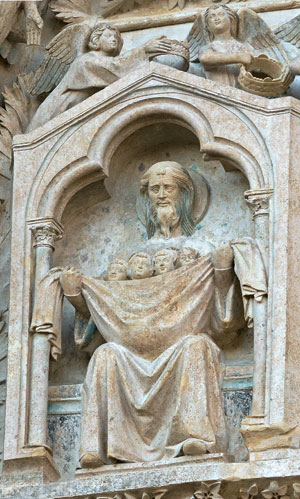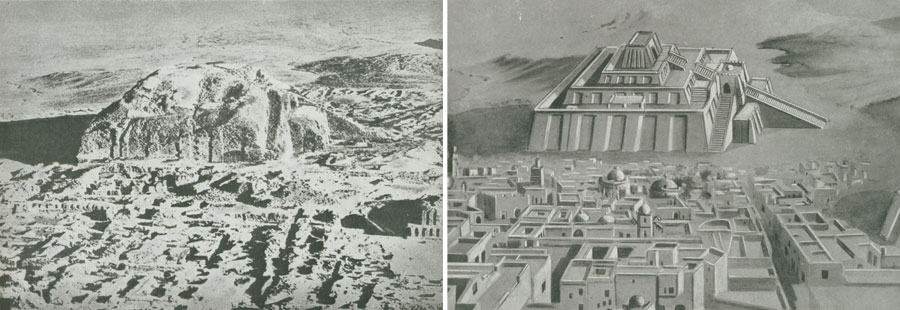Can the Old Testament Be Trusted?
2. The Book of Genesis and biblical archaeology
THE Book of Genesis recounts a series of Covenants that God made with men: with Adam, Noah, and Abraham. God chose Abraham, an Aramaean nomad and promised him descendants and a country: the Land of Canaan. God took His chosen one away from his country, his traditions and his uncertain religion. As a reward for his faith, He promised him His eternal Covenant.

This books ends with a final apparition of God to Jacob, renewing for him His Covenant when this patriarch was leaving the ‘Land’ that had been ‘promised’ to him in order to settle in Egypt, in the land of Goshen, in the eastern part of the Nile delta, with all his family: seventy persons in all.●
Does archaeology give us some clues to the historicity of these very ancient accounts? There are no sites comparable to Har Karkom for this epoch, since the patriarchs and their families were much more discreet than a multitude fleeing Egypt! However, there are still some interesting avenues; here are a few examples.
“The flood continued forty days upon the earth; and the waters increased, and bore up the ark, and it rose high above the earth. The waters prevailed and increased greatly upon the earth; and the ark floated on the face of the waters.” (The Book of Genesis 7:17-18)
Emmanuel Anati’s research allowed him to establish that the mythologies of other peoples do indeed retell this story:
“The story of the ‘universal flood’ in the Bible seems to reflect the collective memory of an ecological event that truly determined the fate of humanity. A similar story is also present in the mythology of Mesopotamia: in it, Noah is called Ziusudra. He builds an ark and saves himself from the flood. The memory of the great flood, however, is [also] recalled in the mythologies of other peoples even on the American continent. [...]
“This disaster dates back more than ten thousand years [...]. The biblical account, even if it appears in this case delightfully epic, might be based on facts around which imaginary embroideries of the oral tradition were later added.”
The geological data also agree, he adds:
“The end of the last ice age in Europe and North America coincides with an intense rainy period in the Middle East. As a result of the thawing of the huge northern glaciers, the level of the Mediterranean and other seas rose by about 120 meters, reaching its current level. Millions of hectares of land were then submerged […].
“The eastern coast of the Mediterranean, in some places, retreated more than 100 km; vast and pleasant plains disappeared forever below sea level. Many animal species became extinct and many tribes of men who lived in these territories were wiped off the face of the earth.”
This text is inspired. So some of its details, which Anati ventures to describe as “imaginary embroideries of the oral tradition,” are not to be despised: the author was led by God to retain them, because they were to be used in His Design for the proclamation of the Holy Church, the universal ark of salvation, for which Noah’s ark is the figurative.
THE TOWER OF BABEL
“Men said: ‘Come, let us build ourselves a city, and a tower with its top in the heavens! Let us make a name for ourselves, lest we be dispersed over the whole earth.’ ” (The Book of Genesis 11:4)
Archaeologists have rediscovered the ruins of the city of Ur, founded in the 5th millennium b.c. The Chaldean city of Ur evokes the Tower of Babel. The biblical account of this sin of pride committed by men alludes to prestigious cities that modern excavations have uncovered in Mesopotamia: Ur, Nineveh, Babylon, Susa. We only knew of them from the Bible, and we rediscovered them based on the indications it gives.

Modern archaeology recreates the plans today, republishing that of the ancient builders of the ziggurats, tall multi-storey towers that dominated these cities, at the top of which was a sanctuary, in Ur, one dedicated to the moon god.●
ABRAHAM
Yahweh said to Abram: “Go from your country and your kindred and your father’s house to the land that I will show you. And I will make of you a great nation, and I will bless you, and make your name great, so that you will be a blessing.” (The Book of Genesis 12:1-2)
Archaeology provides us with some details about Abraham’s country of origin: Among the proud civilisations that wanted to dominate the whole earth “the city of Ur is mentioned only to record the fact that Abraham was called by God to leave it. When we contemplate what remains of it, we realise what an active and flourishing civilisation Abraham left when he responded to God’s call. To depart from Ur for Harran, and even beyond, for an unknown land, was to leave behind a whole world and embark on an adventure about which God alone knew the secret.”●
“At that time the Canaanites and the Perizzites dwelt in the land.” (The Book of Genesis 13:7)

The authors of the “Bible Unearthed” claim to demonstrate that Abraham driving his flocks through the Promised Land could never have existed since, “far from indicating an arid landscape suitable to the life of a shepherd, the strata supposed to be contemporaneous with the emigration of Abraham reveal, at Megiddo for example, in the north of the country, a city-State of approximately 2000 inhabitants. At this period, Canaan was an economically developed region with a very dense network of city-states.”
Precisely! The text does not say otherwise: The Canaanites were in the land, which consequently “was insufficient to support both of them [Abram and Lot] dwelling together” (The Book of Genesis 13:6)! The demonstration of the “Bible Unearthed” really demonstrates nothing at all. Father de Vaux had already written this truth fifty years earlier: “The Patriarchs found a land in which urban and agricultural civilisation was in full expansion.”● “Vast spaces, however, remained free for shepherds,” he added.
One fact supports the new dating that places these events in the 3rd millennium: the concurrence of urban development in Jericho and Meggido (observed by archaeologists and dated to the Early Bronze Age, from 3100 to 2200 BC) with the arrival of the Amorites (from Mesopotamia, like Abraham) in Syria and Palestine, dated to the same period.
“God said to Abraham: ‘Take your son, your only son Isaac, whom you love, and go to the land of Moriah, and offer him there as a burnt offering upon one of the mountains of which I shall tell you.’ (The Book of Genesis 22:2)
“On the third day Abraham lifted up his eyes and saw the place afar off.” (The Book of Genesis 22:4)
Where is this mountain indicated by God? It is not specified in the text, as though it were self-evident. Later tradition identified Moriah with the hill where the Temple of Jerusalem would be built. However, it is not a mountain that is referred to, but a land in which there is a mountain.
Father de Vaux therefore affirmed: “The hypotheses that have been made are all improbable and the place of the sacrifice remains unknown.”
This was before the discovery made by Anati. In fact, within a three day’s walking distance from Hebron, there is only one mountain known as the “mountain of God” on which worship was rendered to God (to Yahweh) from the remotest times. Traces of this worship have been discovered there that date back to the origins of humanity. This mountain is now called Har Karkom.
THE STORY OF JOSEPH
The story of Joseph, the innocent man sold by his brothers and who, after having been honoured by Pharaoh, would save them from starvation, is an admirable figure of redemption.
“Pharaoh said to Joseph: ‘Behold, I have set you over all the land of Egypt.’ ” (The Book of Genesis 41:41)
In the broadcast “The Bible Unearthed,” a French Egyptologist from Cairo is questioned, but his answer is quickly eliminated because it goes against the presenters’ thesis! This answer is however most interesting: “The story of Joseph becoming the minister of Pharaoh is quite possible. The king of Egypt had Semites in his entourage who had been naturalised. They had taken an Egyptian name and had made a career for themselves, sometimes a brilliant one.”
“Then Jacob set out from Beer-sheba; and the sons of Israel carried Jacob their father, their little ones, and their wives, in the wagons which Pharaoh had sent to carry him. They also took their cattle and their goods, which they had gained in the land of Canaan, and came into Egypt, Jacob and all his offspring with him.” (The Book of Genesis 46:5-6)
Paintings from the ancient necropolis of Beni Hassan, dating from the XIXth century BC, allow us to imagine the caravan of the family of Jacob descending to Egypt in order to seek their fortune, in accordance with the marvellous account of Chapters 37 to 50 of the Book of Genesis.

These are excerpts from Can the Old Testament Be Trusted?
A reply to Arte television broadcasts: The Bible Unearthed,
He is Risen, no. 45, May 2006.
The Book of genesis 46:27
All the persons of the house of Jacob, that came into Egypt, were seventy.
After the work of Marcel Dubois, o. p., Dossiers d'archéologie (Archaeology Dossiers) no. 210, 1995
Marcel Dubois, o. p., Dossiers d'archéologie (Archaeology Dossiers) no. 210, 1995
The Hebrew Patriarchs and Modern Discoveries, (Revue biblique, 1949, p. 15.